As an Amazon Associate I earn from qualifying purchases.

If you’ve ever bought pine nuts in the store, chances are you’re eating Chinese imports that are often of dubious origin. And even if you are vigilant about where your pine nuts come from and buy, say Italian pine nuts, you may get high quality, but you pay for it through the nose.
Why aren’t there American pine nuts, you ask? Well, there are. You just have to go find them yourself. It requires some persistence, but here’s how to harvest pine nuts.
First off, you really must live in the West to do this. Unless you can find a stray Italian stone pine planted somewhere as a landscaping tree, eastern pine nuts are too small or have shells too hard to bother with. Sorry, guys.
If you are in the West, you are mostly looking for two types, both called piñons: Pinus edulis and P. monophylla. Yes, a few other pines have good-tasting nuts, chiefly the sugar pine and the gray pine, which I’ve written about before. But the real action is with the two piñons.
Where to find them?
Pinus edulis is mostly a tree of the Southwest, and you can look for is from San Bernardino County in California to most of Arizona, New Mexico and Utah, southern and western Colorado, two southern counties in Wyoming, and two counties outside of El Paso, Texas.
Pinus monophylla is a Great Basin tree, and you’ll find it on the eastern side of the Sierra Nevada in California, as well as throughout SoCal, almost all of Nevada and Arizona, all of western and southern Utah, two southern counties in Idaho, and, weirdly, Luna County in New Mexico.
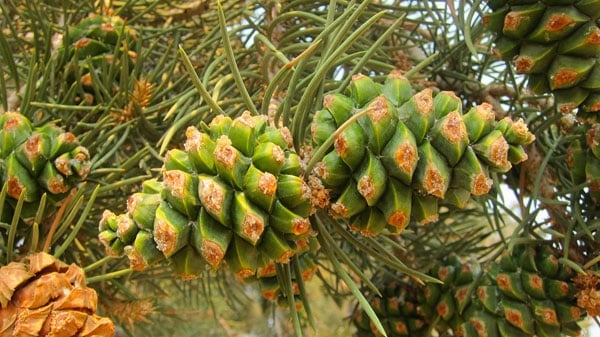
Both are rather scrubby looking pine trees that like the high desert. The tree at right is a singleleaf piñon — P. monophylla — in eastern California and is typical of the species. P. edulis, the two-leaf piñon, is similar-looking if not even scragglier.
Once you find some trees, start scoping them out in early August. You’re looking for trees that have lots of green pinecones on them. Not every tree will set cones, and only Mother Nature knows why. But you can find loaded trees next to barren ones. Sometimes small variations in elevation or whether the trees are on a north or south face of a slope can matter a lot. Once you find the trees, remember where they are.
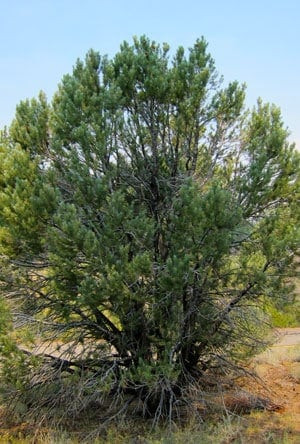
Return to them around Labor Day. It sounds early, but you need to beat the Insane Rodent Posse (IRP) to these tasty nuts. In my spot, there are several chipmunk or ground squirrel holes under each piñon and they are just waiting for each cone to open. I am betting that the nuts are gone within 24 hours of a cone opening. Under no circumstances can you wait until October to gather your nuts, or you risk them all being scurried away by the IRP.
How to gather? First, buy a cheap pair of gardening gloves. The cones are coated in pitch, a sweet-smelling sticky resin that will get on everything. It happens to be one of the most lovely smells in the world, so it’s not all bad. But your gloves will get wrecked, so be prepared for that. Pick each cone into a paper grocery bag.
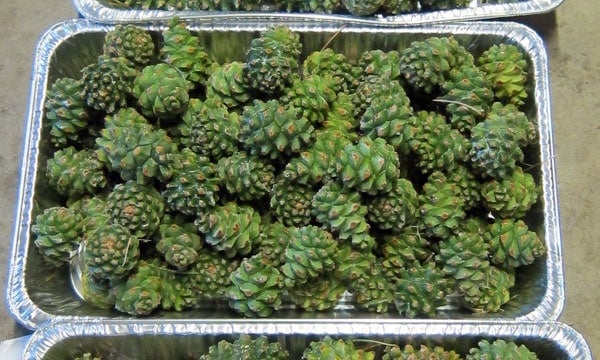
When you get home, lay the green cones out in cheap foil roasting trays or some other shallow, wide container you can stack no more than two cones deep — if you stack them too deep they can get moldy. Enjoy the wonderful aroma and wait. Eventually, they will begin to open on their own.
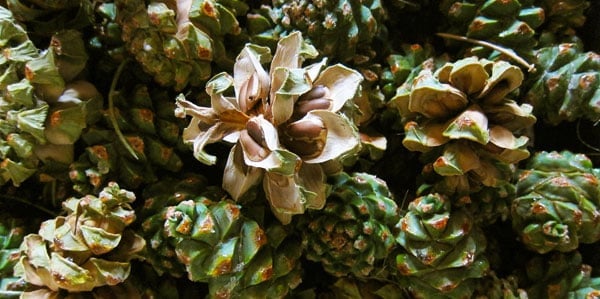
When the cones do open, about 3 weeks or so, pick out all the nuts from within. You’ll get a little pitch on your hands, but it comes off with oil.
Not all nuts will be good nuts, alas. It’s a fact of pine nut processing that can be depressing. All that waiting and work, and sometimes your yield is a crappy 50 percent or worse. It happens. At least there’s an easy way to tell if your nuts are good or not. Dump all the nuts in a bucket of water. About 85 percent of those that float are no good. The sinkers are the keepers.
There is something you can do with the floaters, however. You can mash them up — most won’t have any nut at all inside — fill a Mason jar full and cover it with vodka. Put a lid on the jar, wait a few months and bam! Pine nut bourbon. Damn good stuff.
You’ll notice something: Dark nuts are good nuts. The darker the shell, the more likely the nut is a good one. The nut on the left is a P. monophylla nut, the one on the right is from P. edulis.
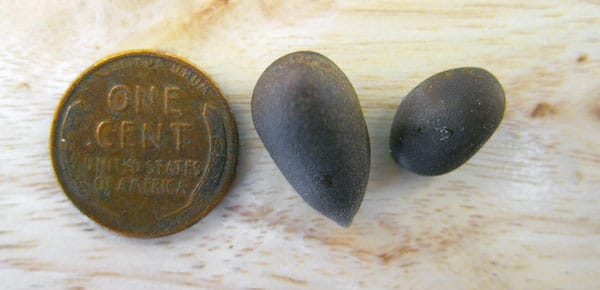
As for the good nuts, you will still need to shell them. See why store-bought pine nuts are so expensive? Sadly, there is no fast way to shell pine nuts. The most effective way is still one at a time, and believe me, I’ve tried lots and lots of different ways to shell these little buggers. This video shows it really well.
Once they’re shelled, freeze the nuts. In fact, freeze even the nuts still in the shell if you plan on keeping them around for more than a couple weeks. Pine nuts are surprisingly perishable. Once frozen, however, in-shell pine nuts will keep for 2 years or more. Oh, and don’t forget to use the shells for more pine nut bourbon…
Looking for pine nut recipes? Here are three of my favorites:
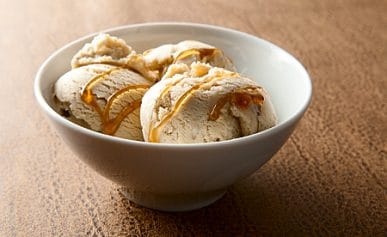
Pine Nut Ice Cream
A pine nut and honey ice cream I am proud of. Awesome drizzled with desert honey, or pine syrup.
Read More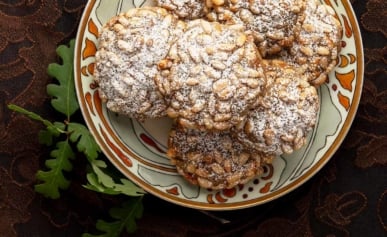
Pine Nut Cookies
Killer pine nut cookies! Easy to make and, like potato chips, hard to eat just one…
Read More
Pine nut encrusted trout reflects the flavors of the Great Basin, where both are native.
Read More




growing up in Arizona our family spent many a day hiking Arizona’s mountains and valleys to harvest this product , we would lay a white bed sheet or two around the base of the tree and shake the branches like crazy until no more nuts fell out , then off to the kitchen where we would slow fry the nuts in butter and garlic salt , once the shells where slightly crunchy let cool shell and enjoy
Which 2 counties in southern Idaho?
Larry: According to the USDA, Cassia and Bannock.
Does harvest date depend on altitude? We’ll be at 7000-7600 feet in western NM second week of August. Any chance it would be a good time to harvest?
Kimi: Yes, definitely check. And remember to bring gloves you can toss because of the pine pitch. AND, be sure you can legally harvest where you are, too.
We didn’t get any that visit, but now we live here — this year was a great pinon year on our land but we waited a little too long! Still got a bucketful, but most were open and on the ground and gobbled up. We have two trays drying and waiting… thanks for this article!
Is there any pinon picking in Southern California?? I’m in riverside! Please help!
Tina: Not this late in the year. But yeah, inland in the San Bernardino forest.
I will be visiting the Albuquerque l
Area the week of thanksgiving is there s picking place near by?
Jamie: Not in November. You need to get there around September.
Thank you so much. I have been picking pine nuts since I was a child however this was the most informative article I have ever seen.
Floating nuts to tell the good and bad how does that go
We are harvesting in northern Utah at around 7000 ft.
We’re harvesting right now in So. Colorado – Loaded!!
We are harvesting the green cones at 7500′ in southern New Mexico. Shells of the few nuts that have spilled out are very hard and will eventually have to be broken individually, maybe spend the winter cracking those little buggers 🙂
It’s fun, the sap is nasty, one piñon will be loaded, the tree right next door, barren of cones.
This year’s harvest in Reno/Virginia City, NV pine nut mountain range was our most organized yet, thanks to your advice. All that rain and snow finally produced a good year for green pine cones. We pick the green cones in August all month and bring them on our deck to dry and open around September. A lot less work and cleaner. We also save the dried pine nut cones and dip them in wax to use as fire starters in winter. They smell divine!
Great post. My wife and I bought 40 acres in a remote northern Arizona area comprised of juniper and pinion pine. In 16 years we had yet to harvest a nut. This Labor Day will be 10 years since building our own cabin and I’m looking forward to a harvest. My wife has a cooking blog @ cookazido.com, and she may do a blog if we’re successful. She especially liked the IRPs. We have the little Kaibab squirrels here as well.
Years ago, while living in Reno, NV my husband and I found a bunch of pinion pines near Virginia City. We collected a slew of them to harvest. We didn’t gather the green cones, we foraged them from the ground. What a ghastly mess! Sap EVERYWHERE! I wish I’d had your advice then. But still, everyone, beware the sap!
I’m really excited to gather my own pine nuts (and I’m even more excited now for pine nuts bourbon!!) But I don’t know how much luck I’ll have up here in Canada. I don’t remember ever seeing big green pine cones, but then again I’ve never looked for pine cones before. I know we have big ones, I just need to remember where I’ve seen them … Thanks for your post!
Our neighbours have a majestic pine tree that has to be at least…100 feet tall and probably close to 90 years old. Every year, the green pine cones catch my eye, but I’m nervous about picking one, partly in case I offend the homeowners and also because I’ve not experience as a forager. Got to get started. Thanks for sharing your know-how!
I live in western Colorado. There seems to be about 7 years between each peak piñon season. And not everyone in my area peaks the same year. This is a peak year at my I house. I have 7 Acres of abundance. I look for the trees that drop the biggest nuts and focus on those few trees.
I scurry under the trees and get a cupful in about 15 minutes. I try to look every day before the piñon Jay’s move in!
I love them!!!
It’s good to know I can freeze them in the shell! Thanks for sharing!
Winona
Pinus edulis is a staple in Buffet’s Chocolates in New Mexico. Good stuff!
Yeah I’m digging the pine nut harvest right now too. We have P. edulis. I get them green in the cones, then half opened so I can see which ones have the dark nuts, then collected from the ground. Mid Sept to mid October at 8,000 feet in Colorado. I cannot stop eating them once I start. That pine nut vodka is good in vodka sauce. Cheers Hank
this is such rockin’ info-
thanks so much!
i want to plant a few pine nut trees–they are my favorite nut, but have difficulty finding info on which will grow in my area: sonoma county
do you have any advice as to which grows best with 14-24 inches of rain, with some coastal fog in the AM?
any difference in height and hardiness of the two american different species?
thanks!! 🙂
We were in Zuni last fall sitting around the table with some good Zuni friends. Carmellita set out a bowl of pine nuts and after she showed me how to crack them in my mouth and spit out the shell I had at it! After awhile my wife and all of our friends were laughing and when I asked what was so funny Kathie informed me that Carellita had given me a Zuni name…..which translates to……fat squirrel! My advice to all. Don’t hog the pine nuts.